Protecting Coral Reefs for Future Generations
From mapping and monitoring to managing reef resources and removing harmful debris, NOAA's Coral Reef Conservation Program supports effective management and sound science to preserve, sustain, and restore valuable coral reef ecosystems.
The livelihoods of millions of people in coastal areas around the world depend on coral reefs. Reefs are important for the biodiversity they sustain and the services they provide: coastal protection, jobs, food, medicines, and recreational opportunities. Unfortunately, the health of coral reefs has been declining for over 20 years. An estimated 20 percent of the world's reefs are now severely damaged and unlikely to recover and about half of the remaining coral reefs are under risk of collapse.
The causes of this crisis are not simple. Local impacts (fishing, tourism, coastal development, and pollution) and global impacts (climate change and acidification) have combined to stress coral reefs. In addition, reefs have always been vulnerable to destructive natural events such as hurricanes or disease outbreaks.
Healthy corals are generally resilient to stress and eventually able to recover. However, natural disturbances are often made worse by human impacts, which reduce the resiliency of corals. Many scientists believe that climate change intensifies these natural disturbances, subjecting coral reefs to stresses such as high temperatures; stronger, more frequent storms; and disease outbreaks.
As human populations grow—especially along the coasts—so will our reliance and affects on coral reefs. If future generations will experience the wonder and many benefits of these underwater rainforests, NOAA and its partners will have to maintain and expand their efforts to understand, manage, and restore the world's coral reefs.
This article describes the major threats to coral reefs and the innovative solutions NOAA has planned for addressing them now and in the future.
Solutions to Specific Coral Reef Threats
Climate Change: Coral Bleaching and the Acidification of the Oceans
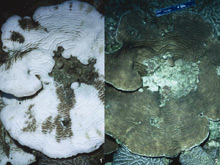
An Agaricia coral colony shown 1) bleached and 2) almost recovered from a bleaching event. Click image for larger view and image credit.
Global climate change is a growing threat to coral reef ecosystems. As temperatures have increased in recent decades, so has the temperature of the ocean's surface waters. These increased temperatures can cause "coral bleaching," during which corals lose the algae that provide them with food. If temperature increases are severe or prolonged, the resulting bleaching can lead to coral death. This ultimately impacts a reef's ability to provide habitat for marine life.
As carbon dioxide levels rise in the atmosphere, they also rise in the oceans, making waters more acidic (called "ocean acidification"). This makes it harder for corals to build their skeletons, which in turn slows coral growth and impacts reef structure, especially after damage or disease events.
Reducing the effects of coral bleaching and ocean acidification will require global cooperation and innovation. NOAA is leading efforts to enhance global capacity to predict and manage bleaching events. NOAA uses remote sensing (satellite observation of the Earth's surface) and in-situ technology (equipment placed in the oceans to measure environmental conditions) to monitor ocean conditions and create models to predict future bleaching conditions.
NOAA developed an automated bleaching warning system that alerts coral reef managers when conditions are right for bleaching. NOAA now monitors the bleaching as it happens, and managers can respond to minimize additional stresses to reefs.
Coastal Development
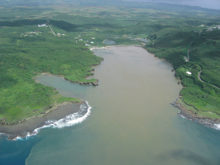
Sediment plumes caused by soil erosion after heavy rainfall, such as this plume in Guam, lead to serious problems in coral reef ecosystems. Click image for larger view and image credit.
Pollution that runs off the land as sediments, nutrients, and other pollutants is a major threat to coral reefs. Pollutants smother coral reefs; accelerate the growth of damaging algae; lower water quality; and make corals more susceptible to disease. Increasing coastal development can cause increased water pollution, thus jeopardizing reefs.
NOAA provides technical guidance to state and territory resource managers to review permits for coastal development and modify damaging activities before they happen. NOAA works with local partners to develop land use plans that promote sustainable economic development while protecting the quality of rivers flowing into the ocean and coastal waters.
NOAA and partners educate students, coastal developers, home-owners, and local decision makers about land use practices that are less damaging to coral reefs. Finally, NOAA supported each U.S. state and territory with coral reefs in developing a "Local Action Strategy," a three-year plan for addressing the most pressing human impacts.
Disease
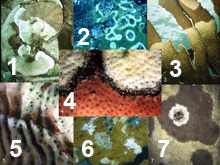
Some of the major coral diseases are pictured above: 1) white plague, 2) yellow band disease, 3) white band disease, 4) black band disease, 5) red band disease, 6) white pox, and 7) dark spots disease. Click image for larger view and image credit.
We know little about coral disease. Many pathogens remain unknown, and the long-term effects on corals are not well understood. Currently, there is no mechanism to translate advances in pathology, biotechnology, and other sciences to the study of coral disease.
In response, NOAA leads a partnership called the Coral Disease and Health Consortium (CDHC). The CDHC is developing tools to understand the causes and effects of disease and links to environmental factors, to assist managers in responding to disease outbreaks and preventing future outbreaks. The CDHC is developing a Web-based tool to guide investigators in diagnosing coral disease and is publishing a comprehensive diagnostic guide and a standardized system to name coral diseases.
The CDHC has also begun sequencing thousands of coral genes. This will help scientists understand coral function under normal and stressful conditions, as well as the relationship between coral and their symbiotic algae, zooxanthellae. By identifying gene changes, or expression, that occur when corals are stressed, scientists can better provide early warnings of disease outbreaks and more accurate predictions regarding survival and recovery.
Finally, NOAA and the CDHC are creating diagnostic laboratories with the technology and forensic expertise to study coral disease, as well as a "rapid response" program with trained local teams that can respond quickly to disease outbreaks.
Overfishing and Destructive Fishing Practices
Coral reef fisheries are a source of food, income, recreation, and livelihood for millions of people around the world. Pressures from human population growth, the emergence of export fisheries, and more efficient fishing equipment have led to overfishing and habitat degradation in the U.S. and globally.
Overfishing is the most widespread threat to coral reefs and occurs on nearly all U.S. inshore reefs. There is increasing evidence that overfishing can alter the ecological balance in reef ecosystems. Also, the use of inappropriate fishing techniques can damage habitats and incur "bycatch" of unintended species, such as turtles, marine mammals, and sea birds.

The practice of blast fishing is destructive not only to targeted species, but also to reef structure and the entire ecosystem. This image shows damaged coral and fish left as waste after a blast in Indonesia. Click image for larger view and image credit.
NOAA, in partnership with regional Fishery Management Councils and the fishing community, has banned the most damaging fishing practices in federal waters and is working to reduce overfishing. However, further advances are needed, especially within state waters, where most coral reefs and fishing occur.
NOAA and partners are studying how and where fish spawn and grow in order to protect sensitive breeding and nursery grounds. NOAA assists in the development of fishing regulations and explores new approaches like the use of fishery reserves as management tools. NOAA also works with enforcement officers, providing support and training to enforce existing fisheries regulations and prevent the illegal catch of protected species. Finally, NOAA works directly with local resource managers and fishing communities to develop plans and approaches to meet society's food and recreation needs while still protecting coral reef fish for future generations.
Overuse from Recreation and Tourism
Tourism is the largest employer in the United States, generating over $700 billion annually. Unfortunately, tourism also impacts the health of coral reefs.
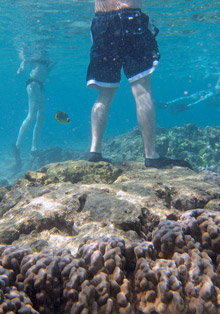
Careless or uninformed snorkelers and divers, such as these in Hawaii, can damage reefs simply by touching them. Click image for larger view and image credit.
Recreational boats damage reefs by improper anchoring or boat groundings. Snorkelers and divers often accidentally break corals. Recreational fishing, an important source of tourism revenue, has grown more rapidly than commercial fishing and increases the pressure on already depleted species. The development of resorts, marinas, ports, and other tourism infrastructure can release various pollutants.
NOAA supports partnerships to educate tour companies, resorts, and dive shops about how to increase and sustain their profits through business practices that protect reefs. These groups are also important partners in tourist education, helping travelers and locals alike learn how to enjoy the reefs without damaging them.
To prevent damage from boats, NOAA funds the installation of buoys that allow boats to moor to a floating buoy rather than drop anchor on the reef. NOAA and partners are installing navigational aids (like buoys to mark reef location) and documenting reef locations on international nautical charts to help vessels navigate coastal waters without running aground on coral reefs.
Broad Solutions to the Range of Coral Reef Threats
Marine Protected Areas
Marine protected areas (MPAs) are a promising tool for protecting coral reefs. An MPA is any marine area reserved by laws or regulations to provide protection for part or all of the resources within the area. The protected resources can be natural or cultural (e.g., a historical shipwreck). An MPA may include areas zoned for specific uses, including "no-take" areas, where no resources can be removed.
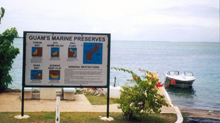
Marine protected areas, such as this marine preserve in Guam, are an important tool in coral reef conservation. Click image for larger view and image credit.
NOAA has mapped and characterized shallow coral reef ecosystems in most U.S. waters, a first step in identifying what needs to be protected. Many U.S. coral reefs occur within NOAA's National Marine Sanctuaries and in the newly designated Northwestern Hawaiian Islands Marine National Monument.
NOAA and partners train state and territory resource managers to effectively design MPAs, identify sites, and assist with management plans and evaluation tools to ensure MPAs achieve needed levels of protection. NOAA and partners are developing an inventory of MPAs with coral reefs, and creating networks of MPAs, enhancing their effectiveness.
Monitoring Coral Reef Ecosystems and Human Uses
A critical aspect of coral reef management plans is understanding what resources occur, how they change over time, how and why people use these resources, and what value they place on continuing to have access to these resources.
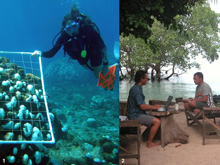
In the first image, a NOAA Biogeography Team diver monitors a reef. In the second image, NOAA's Global Socioeconomic Monitoring Initiative for Coastal Management program trains local coral reef resource managers to collect socioeconomic data through interviews with local resource users. Click image for larger view and image credit.
NOAA monitors coral reef resources and supports state and territory efforts, providing reports on the state of U.S. coral reef ecosystems. NOAA also supports biennial reports on the Status of Coral Reefs of the World. NOAA is coordinating an international partnership called the Global Socioeconomic Monitoring Initiative for Coastal Management. This program provides monitoring tools and survey techniques that measure human attitudes and values, which helps managers develop plans to meet society's needs while ensuring coral reef protection.
Restoration of Damaged Corals
The science of coral reef restoration is still evolving and today is often limited to replacing physical reef structures lost to acute or chronic disturbances and reattaching corals and other invertebrates.

In the first image, a NOAA scientist adds cultured coral larvae to reef rubble in an effort to grow a new colony. In the second, a diver reattaches living coral fragments that have been broken off a reef. Click image for larger view and image credit.
To improve our ability to restore damaged coral reefs, NOAA is studying the success of past projects. Using these data, scientists are developing a tool to predict the success of restoration efforts and comparing restored sites to undamaged sites. NOAA scientists are also exploring ecological approaches to restoration, such as the culture (growth in a laboratory) and release of herbivorous sea urchins, removal of coral predators and developing approaches to collect coral gametes during spawning events, induce fertilization, and seed juvenile corals onto degraded reefs.
Conclusion
Coral reefs are colorful and vibrant underwater communities that provide immeasurable benefits to human societies. However, reefs are threatened by both natural and human disturbances. No one solution can ensure their long-term survival. NOAA continues to try to understand specific threats to coral reefs and work to improve the solutions that simultaneously address several threats to coral reefs at once.
However, NOAA cannot do it alone. Because coral reef decline in many areas is largely a result of human impacts, the solution to this crisis also lies in the hands of individuals and their communities. Even if you don't live near a reef, you can help protect coral reefs. With your help, NOAA will continue to preserve coral reefs for future generations.
Works Consulted
Bryant, D., Burke L., McManus J., and Spalding M. (1998). Reefs at Risk: A map-based indicator of potential threats to the world's coral reefs [Electronic version]. World Resources Institute. Retrieved August 31, 2006, from http://reefsatrisk.wri.org/.
Burke, L. and Maidens J. (2004). Reefs at Risk in the Caribbean [Electronic version]. World Resources Institute. Retrieved August 31, 2006, from http://reefsatrisk.wri.org/.
Endangered and Threatened Species: Final Listing Determinations for Elkhorn Coral and Staghorn Coral: Federal Register Vol 71, No 89, Tuesday May 9, 2006, pg 26852. http://sero.nmfs.noaa.gov/pr/pdf/
71FR266852_Acropora_Final_Listing.pdf.
Fisheries of the Exclusive Economic Zone Off Alaska; Groundfish, Crab, Salmon, and Scallop Fisheries of the Bering Sea and Aleutian Islands Management Area and Gulf of Alaska: Federal Register Vol 71, No 124, Wednesday June 28, 2006 ,pg 36694. http://frwebgate3.access.gpo.gov/
cgi-bin/waisgate.cgi?WAISdocID=05481417940+4+0+0&
WAISaction=retrieve.
International Coral Reef Action Network. (2002). People and Reefs: a partnership for prosperity [Electronic version]. Retrieved August 31, 2006, from http://www.icran.org/doc/icran_wssd_eng.pdf.
Mora, C., Andrefouet S., Costello M.J., Kranenburg C., Rollo A., Veron J., Gaston K.J., and Myers R.A. (2006). Coral Reefs and the Global Network of Marine Protected Areas [Electronic version]. Science, 312 (5781), 1750-1751. http://www.sciencemag.org/cgi/reprint/312/5781/1750.pdf.
NOAA. (2002). NOAA El Nino Page. Retrieved August 31, 2006, from http://www.elnino.noaa.gov/.
NOAA. (2004). CDHC: Coral Disease and Health Consortium. Retrieved August 31, 2006, from http://www.coral.noaa.gov/coral_disease/cdhc.shtml.
NOAA. (2004). Coral Disease Identification and Information. Retrieved August 31, 2006, from http://www.coral.noaa.gov/coral_disease/index.shtml.
NOAA. (2006). 2005 Caribbean Basin Bleaching Event. Retrieved August 31, 2006, from http://coralreefwatch.noaa.gov/caribbean2005/.
NOAA. (April 2006). Economic Statistics for NOAA, 5th Edition [Electronic version]. http://www.economics.noaa.gov/library/documents/
economic_statistics_and_methodology/
NOAAEconomicStatistics-May2006.pdf.
NOAA. (2006). NOAA Coral Reef Watch. Retrieved August 31, 2006, from http://coralreefwatch.noaa.gov/.
NOAA. (2006). Protecting Corals Saving Ships. Retrieved August 31, 2006, from http://savingcoralandships.noaa.gov/.
NOAA. (2006). Satellite Coral Bleaching Monitoring. Retrieved August 31, 2006, from http://coralreefwatch.noaa.gov/satellite/index.html.
Status of coral reefs of the world. (2004). Volume 1. Australian Institute of Marine Science, Townsville, Queensland, Australia. 301 p. Retrieved October 20, 2006, from: http://www.gcrmn.org/status2004.aspx.
U.S. Coral Reef Task Force. (2002). Local Action Strategies. Retrieved August 31, 2006, from http://www.coralreef.gov/las/index.html.
U.S. Coral Reef Task Force. (2002). Resolution 8-1: Improving Procedures of the U.S. Coral Reef Task Force. Retrieved August 31, 2006, from http://www.coralreef.gov/taskforce/pdf/res%208-1.pdf.
Waddell, J.E. (Ed.). (2005). The State of Coral Reef Ecosystems of the United States and Pacific Freely Associated States: 2005 [Electronic version]. NOAA Technical Memorandum NOS NCCOS 11. NOAA/NCCOS Center for Coastal Monitoring and Assessment's Biogeography Team. Silver Spring, MD. 522 pp. http://ccma.nos.noaa.gov/ecosystems/coralreef/coral_report_2005.
Whittingham, E., Campbell, J. and Townsley, P. (2003). Poverty and Reefs, Volume 1: A Global Overview [Electronic version]. DFID-IMM-IOC/UNESCO, 260pp. http://ioc.unesco.org/gcrmn/Poverty%20and%20Reefs/
VOL_1_LOWRES_POVREEF.PDF.
